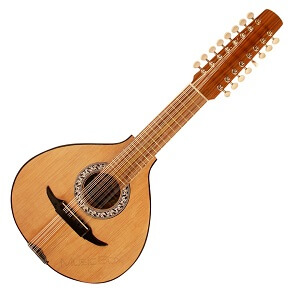Bandola Andina Colombiana
 The Colombian Andean bandola / bandolina is a stringed instrument of the bandola genre , it is plucked with plectrum , of sixteen (16) strings with orders of two doubles and four triples; It derives from the bandurria and the mandolin ; used for the interpretation of traditional Colombian Andean music, due to its versatility and sound, it is also performed in other musical genres, such as: tango , milonga , polka , etc. It is usually performed alone or accompanied with tiple and guitar, forming traditional Andean Colombian and student trios, or being part of musical groups of: bandolas or symphony.
The Colombian Andean bandola / bandolina is a stringed instrument of the bandola genre , it is plucked with plectrum , of sixteen (16) strings with orders of two doubles and four triples; It derives from the bandurria and the mandolin ; used for the interpretation of traditional Colombian Andean music, due to its versatility and sound, it is also performed in other musical genres, such as: tango , milonga , polka , etc. It is usually performed alone or accompanied with tiple and guitar, forming traditional Andean Colombian and student trios, or being part of musical groups of: bandolas or symphony.
The bandolina (Colombian Andean bandola) acquires its name from the geographical location where it was developed. This area is called the Andean Region of Colombia , which is made up of the following departments : Antioquia , Boyacá , Caldas , Cauca , Cundinamarca , Huila , Nariño , Norte de Santander , Quindío , Risaralda , Santander , Tolima and Valle del Cauca . The bandolinIt is the melodic instrument par excellence in the traditional rhythms of the folklore of this region, such as the bambuco , the aisle , the dance , the guabina , the whirlwind , among others. The original name of bandolina [ 1 ] was assigned (to this musical instrument) in a popular way in the department of Meta (Colombia) , when the Colombian Andean bandola (16 and 14 strings) was used, in groups of joropo, until mid-20th century, along with the names of lira and matamata; This also influenced musical evolution, due to its use in the joropo, in the Colombian Araucanian region, extending the name to another formed chordophone , the llanera bandolina (Araucanian musical instrument).